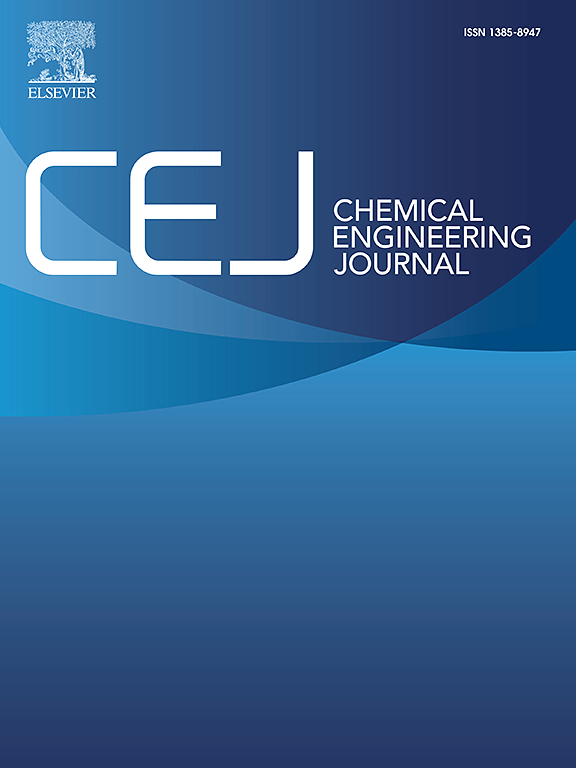多功能木质复合材料用聚酯交联网
IF 13.2
1区 工程技术
Q1 ENGINEERING, CHEMICAL
引用次数: 0
摘要
木材是一种天然的生物材料,在全球碳中和中发挥着重要作用。为了优化其应用,需要对木材进行改性,以克服尺寸稳定性、绝对强度和耐微生物性方面的缺点。木材中柠檬酸与山梨糖醇(SorCA)原位聚合是一种绿色有效的改善木材性能的方法;然而,不同的聚酯交联网络具有显著而复杂的影响。通过调整单体比例,聚酯结构从线性变化到高度交联,改变了与木材组分的多尺度相互作用。高交联密度聚酯形成于纤维素无定形区,其中化学键和分子间力诱导纤维素链排列更有序。这增强了抗水性,机械性能得到改善,包括弹性模量增加138.6% %,破裂模量增加14.7% %,抗压强度增加110.7% %,扩大了结构应用的潜力。相比之下,线性聚酯能够与木质素形成醚键,通过木质素-碳水化合物复合物(LCC)相互作用形成紧凑的网络。这抑制了木材在潮湿条件下的尺寸变化,提供理想的湿度稳定性。此外,线性柔性网络减轻了刚性聚酯造成的韧性损失。纤维素结构优化和聚酯交联网络增强之间的协同作用重建了木材的纳米级超微结构,使性能定制复合材料成为可能。通过揭示木材聚酯的“结构-性能”响应机制,提出高性能、可持续的木材复合材料开发新策略。本文章由计算机程序翻译,如有差异,请以英文原文为准。


Tailoring polyester crosslinking networks for multifunctional wood composites
Wood is a natural biomaterial and plays an important role in global carbon neutralization. To optimize its application, wood modification is needed to overcome drawbacks in dimensional stability, absolute strength, and microbial resistance. The in-situ polyesterification of citric acid and sorbitol (SorCA) in wood is a green and effective method to improve its properties; however, different polyester crosslinking networks have significant and complex effects. By adjusting the monomer ratio, the polyester structure varies from linear to highly crosslinked, altering multiscale interactions with wood components. High crosslinking density polyesters form in cellulose amorphous regions, where chemical bonds and intermolecular forces induce a more ordered cellulose chain arrangement. This enhances water resistance, with mechanical performance improvements including a 138.6 % increase in modulus of elasticity, a 14.7 % increase in modulus of rupture, and a 110.7 % increase in compressive strength, expanding the potential for structural applications. In contrast, linear polyesters enable ether bonding with lignin, forming compact networks via lignin-carbohydrate complex (LCC) interactions. This suppresses wood's dimensional changes in humid conditions, offering ideal moisture stability. Moreover, the linear flexible network alleviates the toughness loss caused by rigid polyesters. The synergy between cellulose structural optimization and polyester crosslinking network reinforcement reconstructs wood's nanoscale ultrastructure, enabling performance-tailored composites. By unveiling the “structure–property” response mechanism of wood polyesterification, this study proposes new strategies for high-performance, sustainable wood composite development.
求助全文
通过发布文献求助,成功后即可免费获取论文全文。
去求助
来源期刊

Chemical Engineering Journal
工程技术-工程:化工
CiteScore
21.70
自引率
9.30%
发文量
6781
审稿时长
2.4 months
期刊介绍:
The Chemical Engineering Journal is an international research journal that invites contributions of original and novel fundamental research. It aims to provide an international platform for presenting original fundamental research, interpretative reviews, and discussions on new developments in chemical engineering. The journal welcomes papers that describe novel theory and its practical application, as well as those that demonstrate the transfer of techniques from other disciplines. It also welcomes reports on carefully conducted experimental work that is soundly interpreted. The main focus of the journal is on original and rigorous research results that have broad significance. The Catalysis section within the Chemical Engineering Journal focuses specifically on Experimental and Theoretical studies in the fields of heterogeneous catalysis, molecular catalysis, and biocatalysis. These studies have industrial impact on various sectors such as chemicals, energy, materials, foods, healthcare, and environmental protection.
 求助内容:
求助内容: 应助结果提醒方式:
应助结果提醒方式:


